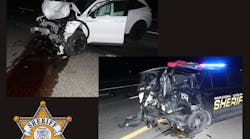It’s interesting that an agency can be either too big or too small to have personally assigned vehicles. Too small and they can’t afford it; too big and they can’t afford it. Usually, an agency with ten sworn at a minimum is where you start seeing personally owned vehicles assigned. That usually works in the budget until you get over 2,500 to 3,000 sworn and the cost can get prohibitive. The cost of the vehicles isn’t the only issue though. The cost of maintenance can get pretty expensive. The big argument is whether it’s more or less expensive to maintain personally assigned vehicles or pool cars that are shared.
It’s no surprise to any officer that a personally assigned patrol vehicle is usually better cared for. The officer, after all, has to get in it day in and day out and is held responsible for it’s cleanliness, appearance, maintenance of gear, etc. Pool cars tend to be a bit more abused as you never know what condition it’s going to be in when you get it and no matter what gear it does or doesn’t have, unless an unsafe condition is created, it’s what you’re stuck with. In that case, most officers bring the stuff they have to have for a shift, fully expecting that they’ll do the vehicle inventory and document what’s missing for the tenth time.
Almost every agency tracks how many miles are put on their cars, personally assigned or shared, and many have a cap—a target number of miles at which the vehicle is set for replacement. For some agencies that number might be 50K; others might be 100K. Some might be, “when it dies we’ll have to replace it.”
Consider the difference in appearance and maintenance of a personally assigned vehicle versus a patrol vehicle when they both have 50,000 miles on them. The personally assigned vehicle will be in better condition both inside and out, and the maintenance records will be properly documented. The shared/pool car? Probably not so much. Aside from pride of possession and responsibility, what makes the difference so glaring is how those miles are put on.
A patrol vehicle that sees mostly highway miles, such as those used by highway patrol or state troopers, is usually considered less abused. Sure, the average speed might be a bit higher, but the miles are “easy” as compared to the stop and go and time spent loitering with the motor running in any city patrol vehicle. The difference in appearance, maintenance and general use could require that the city vehicle be replaced at 50K while the highway vehicle might see another 50K to 100K before needing replacement.
Is there a better way?
Enter the police agencies for many a large international airport in the U.S. They certainly keep track of miles put on patrol vehicles for the purpose of justifying vehicle count and patrol function, but for the purposes of maintenance and replacement, the HOURS of use are tracked and used. These patrol vehicles are outfitted with a device that tracks the number of hours the motor is run. By using that number and the number of miles on the vehicle in a given date range you can see the average miles per hour of use that are put on the vehicle.
It should come as no surprise that the lower the miles per hour are, the more maintenance the engine and drive train will require. The consumable vehicle fluids, such as oil, transmission, break and power steering, are usually serviced based on the number of miles driven, but should they be?
As was discussed, an eight hour shift in the inner city is usually much harder on a vehicle due to all of the stop and go and idling use as compared to a highway patrol vehicle where much of it is simply cruising. Should those two vehicles receive the same maintenance at 3,000 or 5,000 miles? Or might the inner city vehicle need the same maintenance at 3,000 miles that the highway vehicle doesn’t need until 5,000?
It might surprise you to learn but the average patrol vehicle driven primarily for highway patrol only averages 35mph across the life of its use. Why? It still has to go from driveway to station to patrol to calls to patrol to meal stops to patrol to station (you get the idea). It’s not ALL highway miles and speeds. An inner city patrol vehicle is far less—sometimes in the 10 to 12mph range. All of the stop and go, idling and top speeds of 30mph between lights really drags the total average MPH of the vehicle down across its lifespan.
By tracking the number of hours on your patrol vehicles in addition to the total miles driven, you can get a good idea of the average speed the vehicle sees across its service life. The maintenance schedule should obviously be adjusted so that the vehicle gets serviced more frequently when it has a lower average life span speed of use and a less frequent service schedule when it has a higher average life span speed of us.
The biggest challenge many fleet managers will have in justifying this type of maintenance schedule and tracking is the addition of the equipment to track the hours the vehicle is run. Some manufacturers have this time tracking built into their vehicle software/firmware capabilities but only in higher trim packages. If it’s not already available in the vehicles your agency is purchasing (usually not your choice because it’s on a bid contract), then the equipment would need to be purchased and installed. That’s more cost and more work, but if it saves you time and money in maintenance through the life span of the vehicle, does the savings offset the initial expense? That’s something you have to track and figure out for your agency before you take the suggestion up your chain of command, it might prove well worth it in the long run.



